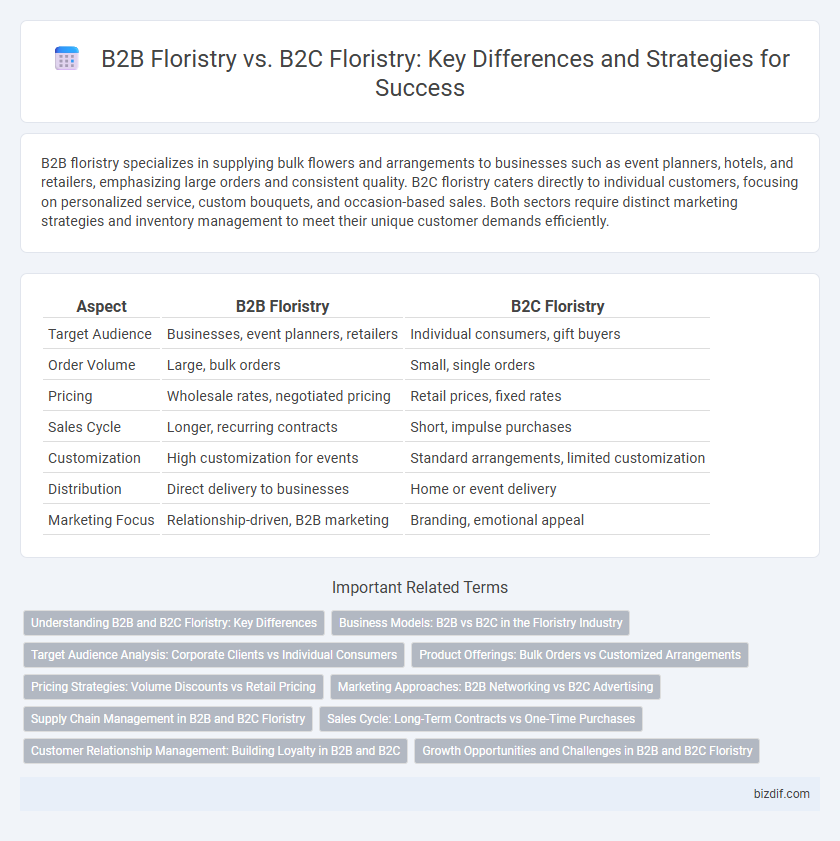B2B floristry specializes in supplying bulk flowers and arrangements to businesses such as event planners, hotels, and retailers, emphasizing large orders and consistent quality. B2C floristry caters directly to individual customers, focusing on personalized service, custom bouquets, and occasion-based sales. Both sectors require distinct marketing strategies and inventory management to meet their unique customer demands efficiently.
Table of Comparison
| Aspect | B2B Floristry | B2C Floristry |
|---|---|---|
| Target Audience | Businesses, event planners, retailers | Individual consumers, gift buyers |
| Order Volume | Large, bulk orders | Small, single orders |
| Pricing | Wholesale rates, negotiated pricing | Retail prices, fixed rates |
| Sales Cycle | Longer, recurring contracts | Short, impulse purchases |
| Customization | High customization for events | Standard arrangements, limited customization |
| Distribution | Direct delivery to businesses | Home or event delivery |
| Marketing Focus | Relationship-driven, B2B marketing | Branding, emotional appeal |
Understanding B2B and B2C Floristry: Key Differences
B2B floristry involves supplying flowers and arrangements to businesses such as event planners, hotels, and corporate offices, emphasizing bulk orders, long-term contracts, and consistent quality. B2C floristry targets individual customers purchasing for personal events or gifts, focusing on personalized service, variety, and timely delivery. Understanding these distinctions helps florists tailor marketing strategies, inventory management, and customer service approaches to meet the unique demands of each market segment.
Business Models: B2B vs B2C in the Floristry Industry
B2B floristry involves wholesale transactions where florists supply bulk flowers and arrangements to retailers, event planners, and corporate clients, emphasizing volume, consistency, and long-term contracts. B2C floristry targets individual customers seeking customized bouquets and floral services for personal occasions, focusing on personalization, experience, and immediate delivery. The B2B model prioritizes efficient logistics and cost-effective sourcing, while B2C relies heavily on marketing, customer engagement, and same-day service options.
Target Audience Analysis: Corporate Clients vs Individual Consumers
B2B floristry targets corporate clients such as event planners, hotels, and businesses seeking bulk floral arrangements or regular installations, prioritizing reliability, scalability, and brand alignment. B2C floristry caters to individual consumers focused on personalized, often seasonal or occasion-specific purchases, emphasizing aesthetic appeal and emotional connection. Understanding these distinct target audiences enables florists to tailor marketing strategies, product offerings, and customer service approaches effectively.
Product Offerings: Bulk Orders vs Customized Arrangements
B2B floristry specializes in bulk orders, offering standardized floral products tailored for events, retailers, and corporate clients seeking large quantities at competitive prices. B2C floristry focuses on customized arrangements, providing personalized bouquets and unique floral designs to meet individual customer preferences and special occasions. The distinction in product offerings reflects differing priorities: efficiency and volume for B2B versus creativity and personalization for B2C.
Pricing Strategies: Volume Discounts vs Retail Pricing
B2B floristry leverages volume discounts to incentivize bulk purchases, often offering lower per-unit prices to businesses like event planners and retailers. In contrast, B2C floristry employs retail pricing strategies that emphasize individual sales with higher margins, reflecting the convenience and personalized service demanded by end consumers. Pricing models in B2B floristry prioritize long-term contracts and repeat business, while B2C pricing focuses on competitive rates and seasonal promotions to attract daily customers.
Marketing Approaches: B2B Networking vs B2C Advertising
B2B floristry marketing emphasizes strategic networking, building long-term relationships with event planners, hotels, and corporate clients through personalized outreach and industry partnerships. B2C floristry relies heavily on targeted advertising channels such as social media, search engine marketing, and seasonal promotions to attract individual consumers and boost brand visibility. Leveraging data analytics and customer insights is critical for both sectors to tailor marketing efforts and maximize engagement effectively.
Supply Chain Management in B2B and B2C Floristry
B2B floristry supply chain management emphasizes bulk purchasing, streamlined logistics, and long-term supplier relationships to ensure consistent flower quality and availability for retailers and event planners. In contrast, B2C floristry supply chains focus on rapid inventory turnover, personalized packaging, and direct-to-consumer delivery to meet seasonal demand and individual preferences. Effective inventory forecasting and real-time demand analytics are critical in both models to minimize waste and optimize freshness.
Sales Cycle: Long-Term Contracts vs One-Time Purchases
B2B floristry involves long-term contracts with clients such as event planners, hotels, and corporate offices, leading to extended sales cycles focused on relationship building and consistent service delivery. In contrast, B2C floristry caters to individual customers seeking one-time purchases for occasions like birthdays, anniversaries, or holidays, typically resulting in shorter sales cycles with immediate transactions. The B2B model emphasizes contract negotiations and ongoing floral supply management, while B2C prioritizes quick fulfillment and seasonal promotional strategies.
Customer Relationship Management: Building Loyalty in B2B and B2C
Effective Customer Relationship Management (CRM) in B2B floristry centers on long-term partnerships, personalized service, and tailored solutions that meet the specific needs of businesses like event planners and retailers. B2C floristry CRM emphasizes emotional engagement, personalized experiences, and prompt responsiveness to foster customer loyalty and repeat purchases from individual buyers. Utilizing CRM software with segmentation and automated follow-ups enhances retention strategies in both B2B and B2C floral markets.
Growth Opportunities and Challenges in B2B and B2C Floristry
B2B floristry offers significant growth opportunities through bulk sales and long-term contracts with event planners, hotels, and corporate clients, yet it faces challenges in supply chain management and meeting large-scale, consistent quality demands. B2C floristry thrives on personalized customer experiences and seasonal trends, driving higher profit margins but encountering fierce competition, fluctuating demand, and the need for effective online marketing strategies. Both sectors require adaptation to sustainability practices and digital innovations to capitalize on evolving market dynamics and consumer preferences.
B2B Floristry vs B2C Floristry Infographic

 bizdif.com
bizdif.com